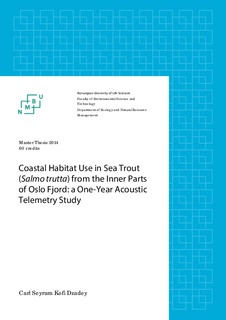| dc.description.abstract | Fish have a wide variety of feeding habitats and feeding patterns, making them a good experimental model for the study of feeding behaviour. Recent studies show that fish forage actively when perceived risk is low, but decrease foraging and increase vigilance when perceived risk is high. Several studies also show that fish feed more as group size increases and as perceived risk decreases. Feeding of trout in freshwater has been well described but there is insufficient knowledge about their feeding behaviour when at sea. The Acoustic telemetry was applied to explore the movements and habitat use of sea trout (Salmo trutta L.) in the Oslo fjord in Norway. Specifically, what habitat type sea trout prefer and the aspect of area use that relates to both individual as well as season specific characteristics were explored. Furthermore, the study investigated whether sea trout are selective in their habitat use, and the effect of season, water temperature and salinity on the utilization of sea depth by sea trout. In all, nine (9) trout were tagged with VEMCO and THLEMA identification tags. The average (mean ± SE) length of the studied trout was 44 ±5.87cm. All fishes were monitored with stationary hydrophones in addition to manual tracking over the entire study period. Concerning area use, sea trout explored larger area as they moved out of the study area (how big was the study area?). However, there was no significant difference in size relating to area use, but evidence of growth-compensating habitat use, where larger sea trout using relatively small habitat area was found. Concerning temperature use, sea trout appears to be selective in their temperature use. The preferred temperature range was 6-7 ºC. The evidence of growth-compensating habitat use suggest the need for more study on how to prevent slow growers from being attacked by predators or caught by fishermen after being chased away by more dominant and larger individuals. This will also lead to a better foundation for understanding the dynamics of large activity area used by sea trout. | nb_NO |
